Abstract
Highland pastoralism provides economic sustainability to the tribal livelihoods and is endemic to the yak-rearing tracts of India. Transhumant pastoralists of Arunachal Pradesh (in India) have centuries-old deep socio-religious and economic connections with this unique bovine species. As a result of their conservation efforts, Arunachali was recognized as the first and is still the lone breed (to date) of yaks in the country. A survey was conducted on the pastoral production system in the region to enable the phenotypic characterization of yaks and to understand the prevailing husbandry practices. Arunachali yaks are medium-sized bovines that are predominantly black with dense and long hairs hanging down the body and are docile in temperament. They have a convex head with horizontal ears and distinctly curved horns with pointed tips. The average milk yield is 0.98–1.04 kg milk/day with 7.45% fat and 11.5% SNF and the peak milk yield/day is 1.1–1.6 kg. The average ages of clipping of coarse hairs and down fibres are 12–18 months and 12 months, respectively, with average yields of 1.5 kg and 0.5 kg/clipping/animal, respectively. Value addition of yak milk and fibre presents a unique opportunity for the economic rejuvenation of yak pastoralism. However, winter feed scarcity, inbreeding, extreme climate events and the non-availability of essential services are still major challenges for yak production in the country. Our findings acknowledge that pastoral sustainability is critical for the conservation of yaks and yak rearing. This calls for pastoralism-centric governance and research efforts in the highlands to curb the declining population and to put Indian yaks on the road to sustainability.
1. Introduction
Transhumant pastoralism is an important component of highland socio-economic systems since it provides sustainable and ecofriendly livelihood support to the pastoral communities. The pastoral ecosystems present an opportunity to utilize some of the most pristine and ecologically rich regions for sustenance and biodiversity conservation [1]. Pastoralism in Indian highlands entails the seasonal movement of livestock, along with the herders, in order to utilize the sparse and inaccessible resources [2]. Hence, the economic returns generated in this system with almost zero input costs make it highly sustainable [3]. Besides livestock mobility, pastoral highlanders have developed several effective socio-ecological mechanisms for environmental and economic sustainability, viz., regimes for the management of common pasturelands (thus preventing overgrazing and soil erosion), herd diversification practices (keeping livestock species, along with cross-hybrids, at differing altitudes and vegetations as insurance against natural calamities), critical knowledge of the natural rangelands (which is an intellectual treasure of locally available forage and medicinal plants) and deeply entrenched cultural linkages with livestock species [4,5,6]. Thus, the role of pastoralists is crucial in the conservation and maintenance of livestock populations that are adapted to high-altitude environments.
Lately, traditional pastoralist production systems are weakening due to factors such as climate change, livestock–wildlife conflicts, intensification in farming, government apathy and a lack of availability of basic services [7]. The waning transhumant lifestyle will lead to severe losses on ecological, socio-cultural and economic fronts, with the most challenging being biodiversity loss [8]. Species that are predominantly transhumant and reared by pastoralists, such as yak and mountain cattle, will be threatened to extinction if they are not sufficiently supported [9]. Furthermore, the Indigenous traditional knowledge (ITK) available to pastoralists regarding the medicinal, forage and other uses of the high-altitude flora will be lost forever [10].
In the trans-Himalayan region of India, yak pastoralism is a major source of sustenance for tribal nomads whose economy and livelihood depend heavily on the efficient utilization of high-altitude grazing lands [11]. Transhumant yak farming is seasonally cyclic in the sense that it involves vertical migration of the yak herders and their animals between highland pastures in summers and lower rangelands in winters [12]. Yak pastoralists have a subsistence economy that heavily relies on the availability of forage resources and the suitability of the weather conditions [13]. Modernization and changing socio-economic scenarios have enforced mass desertions from pastoral yak farming, with the younger generation unwilling to adopt this tough life of risk and uncertainties vis-à-vis meager remuneration [14].
Yaks are the epitome of pastoral resilience; therefore, community participation and engagement are critical for the conservation of yaks in India [15]. The dwindling yak population can be stemmed only if pastoral communities are able to derive higher dividends from the occupation. This, in turn, is possible only through the prioritization of unique populations for governmental and institutional support in the form of genetic improvement programmes and the implementation of pastoral-friendly policies [16]. Characterization and registration of distinct yak germplasm as a breed would be the first step towards achieving this objective [17].
The north-eastern state of Arunachal Pradesh in India is home to a unique yak (Peophagus grunniens) population reared by tribal pastoralists (or Brokpas); this yak species demands immediate conservation and genetic improvement efforts [18]. Therefore, this study was conducted to phenotypically characterize the Arunachali yak and document the prevailing transhumant production systems to ensure the pastoral sustainability of the population.
2. Methodology
2.1. Study Area Description
Arunachal Pradesh is the largest among the north-eastern states of India and has an area of 83,743 km2, which is divided into 26 administrative districts. Out of these 26 districts, the highlands (3000–6000 m MSL) of Tawang (90°15′ E and 27°45′ N) and West Kameng districts (91°30′ E–92°40′ E and 26° 54′ to 28°01′ N) are the home tracts of Arunachali yak, which comprises approximately 41% of the total yak population of the country [19].
The average human population density of the two districts is reported to be 11–12 per sq. km. The topography of both the districts is mostly mountainous with alluvial and residual soil types predominantly found in the majority of the areas. The Arunachali yak breeding tract is a huge repository of oak (Quercus spp.), blue pine (Pinus spp.), birch fir, birch rhododendron scrub and mixed coniferous forests.
Yak rearing is prevalent in the northern belt of the two districts at 3000–6000 m above mean sea level. In the Tawang district, the temperature is the lowest and highest in February (minimum temp.: −6 °C) and mid-August (maximum temp.: 23 °C), respectively, with the maximum rainfall in July (average rainfall: 1828 mm). In the West Kameng district, December and January are recorded as the coldest months (minimum temp. −5 °C), whereas July and August witness the highest temperatures (maximum temp.: 30 °C). The rainy season starts in April and continues up to November (average rainfall: 1607.4 mm). In both districts, snowfall occurs from mid-November to February.
The survey was conducted in the yak tracts of the two districts from December 2013 to December 2015. The data was particularly recorded in the winter months when the herders migrated down to lower altitudes with their animals. All six administrative blocks of the Tawang district, viz., Kitpi, Lumla, Mukto, Tawang, Thinghbu and Zemithang, and two community development blocks of the West Kameng district, viz., Dirang and Kalaktang, were considered for this study.
2.2. Sampling Technique and Traits Considered
A stratified random sampling technique was employed to select 47 different households of yak pastoralists (who were surveyed) in the Tawang and West Kameng districts; the survey extended over twenty-four months. In the Tawang district, survey data was collected from Jang, Thinghbu, Sharo, Rho, Jangda and Zemithang, whereas, in the West Kameng district, data was collected from Mandala top, Banglejeb, Shingchong, NagaGG, Dongchikpu, Wangdorpo, Tseskang and Nyukmadung. The surveyed state and the districts are shown in Figure 1. Scientific breed descriptions and questionnaires were also undertaken to collect all possible relevant information. A total of 1437 Arunachali yaks were measured, which included 116 calves (up to one year of age), 196 animals from 1–3 years of age, 653 adult females and 472 adult males of different breed characteristics (Figure 2). The study also collected data from 130 yak–cattle hybrids.
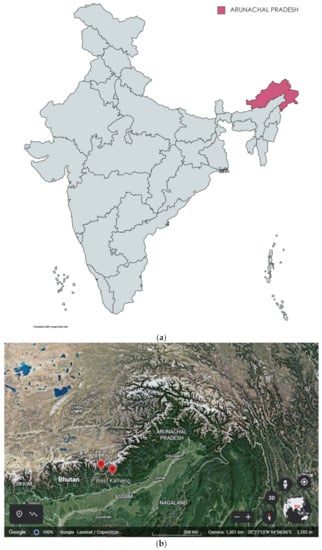
Figure 1.
(a) Map of India with Arunachal Pradesh highlighted. (b) Google Earth view of the Tawang and West Kameng districts on the western border of Arunachal Pradesh.
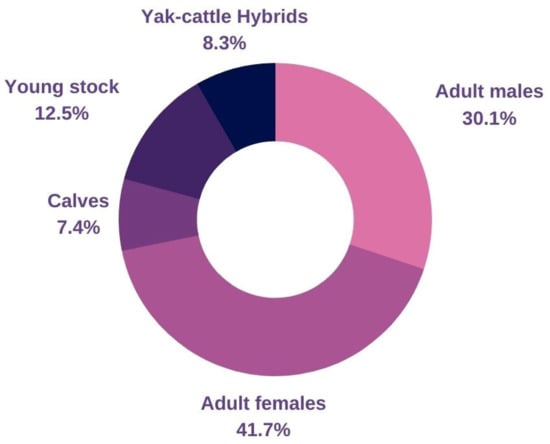
Figure 2.
Distribution of different categories of yaks included in the survey.
The recorded traits included the morphological features of general body appearance, coat colour, hair colour, head morphology, horn shape and appearance of a hump, and udder and teats. Animals with a single body colour were attributed as pure black, pure brown, pure white, etc., whereas those with a mix of white along with black or brown were designated as black and white, brown and white, etc.
Furthermore, morphometric traits such as chest girth, body length and height at the withers were also recorded using a measuring tape. The chest girth was measured from a point just behind the shoulder blade and all around the body of the animal. Body length was measured as the distance between a point of the shoulder and the pin bone, whereas the height at the withers was the height from the highest point of the withers to the ground [20].
The survey of yak herders for various performance parameters for milk production (daily milk yield, peak milk yield, days to reach peak milk yield, lactation length, lactation milk yield, dry period, productive life span, fat and SNF percentage in milk), growth (birth weight, pre-weaning weight, 12 months weight, 24 months weight, weight at first mating, weight at first calving, adult weight), fertility (age at first mating, age at first mounting in males and age at first oestrous, oestrous cycle duration, oestrous duration, age at first mating, age at first calving, interval from calving to conception, calving interval, gestation length, number of calvings, twinning percentage, percentage of dystocia, placental retention, abortion, stillbirth and post gestational mortality) and fibre (age at clipping, weight of clipping, hair fibre proportions, hair diameter and hair texture were recorded both for coarse hairs and the soft undercoat) was also undertaken. Thirty (30) animals from each district were measured from the fifth day of calving onwards over thirty days to calculate the average milk yield. Milk composition data, i.e., fat and SNF percentage in milk were generated through a Lactoscan milk analyzer. The body weight of the animals at different ages was also calculated using Schaeffer’s formula. Yak hair fibre length was measured using vernier calipers, whereas the hair diameter measurements were recorded using a micrometer. The tolerance of yaks to extreme weather events such as drought, heat and cold was determined based on the herders’ responses. Herders were asked to rate their animals on a scale of 1–5 regarding the tolerance to extreme drought, heat and cold weather events as follows: 1—very high tolerance, 2—high tolerance, 3—average tolerance, 4—poor tolerance and 5—very poor tolerance.
2.3. Statistical Analysis
Descriptive statistics, including means and standard deviations, were calculated for various performance and morphometric traits. Subsequently, one-way ANOVA was employed to identify the significant differences between regions regarding milk production using SPSS v28.0 [21]. The tolerance scores of yaks to drought, heat and cold were assessed based on the responses provided by the herders of both regions.
2.4. Evaluation of Production Systems
Different aspects of the production system such as the socio-economic status of the herders; migration patterns; husbandry practices, such as feeding, housing and management of prevailing diseases and animal utility, were recorded to evaluate the existing pastoral systems and to identify the potential threats. Information regarding the prevailing diseases was obtained from the herders via descriptions of the clinical signs and symptoms, showing photographs, etc. The Indigenous traditional knowledge (ITK) of the yak pastoralists was also recorded to document the knowledge and practices of the tribal herders.
3. Results and Discussion
3.1. Morphological Traits
Arunachali yaks are medium-sized bovines with a thick skirting of hairs all over the body and a docile temperament. The predominant coat colour was black, although dark brown, light brown, white-brown, white and grey animals were also seen (Figure 3). Animals with black bodies and white stripes of hairs running from the hump to the tail were also noticed. Black coats are predominant in the yaks of China as well and are considered the wild type, whereas the Tianzhu breed of Chinese yaks is completely white [22,23]. The high frequency of black coat color seen in yaks throughout the world may, in fact, be an adaptation to conserve body heat in extremely cold environments [24].
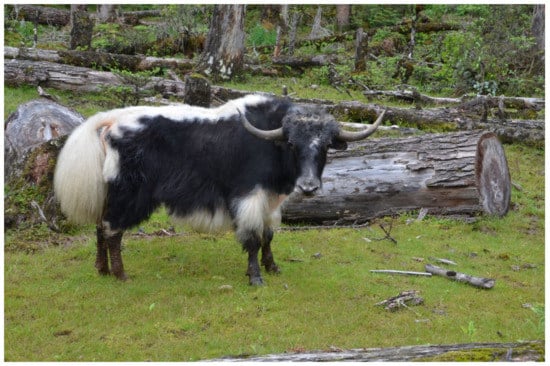
Figure 3.
Morphological features of Arunachali yaks.
These animals generally have black, curved horns placed forward with pointing tips. This is also an important adaptive response for self defence at high altitudes [25]. A convex head with a prominent poll and horizontal ears are typical features. Horns and humps are larger in males than in females. Females have medium-sized udders (as compared with other bovines), which are generally trough-shaped with two pairs of cylindrical teats. The complete morphological description of both the sexes is presented in Table 1 and the different colours and horn types that were seen in Arunachali yak are shown in Figure 4 and Figure 5.

Table 1.
Morphological description of Arunachali yaks.
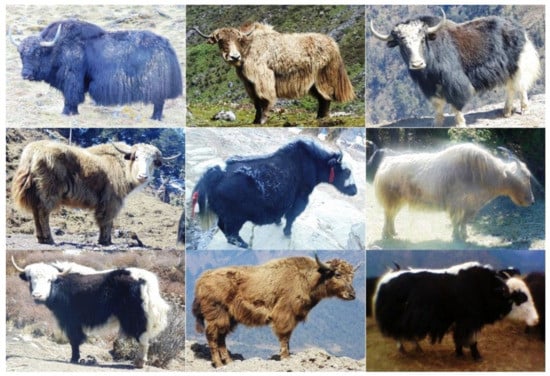
Figure 4.
Colour patterns seen in Arunachali yaks.
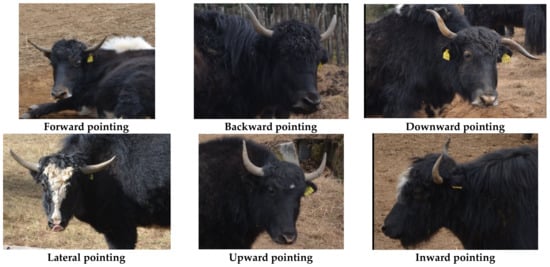
Figure 5.
Different horn types and shapes in Arunachali yaks.
3.2. Morphometric Traits
The characterization of morphometric traits of a population provides important evidence of its developmental evolution, and hence, facilitates breed differentiation [26]. The morphometric traits are indicative of the animal conformation, which, in turn, is associated with production and functional traits [27,28]. The morphometric traits that were measured included chest girth, body length and height at the withers. As per expectations, sexual dimorphism existed for all the recorded traits. The recorded morphometric traits are presented in Table 2. The average male body length found in our study was comparable to Jiulong yaks of China, which are over 160 cm in length. However, the chest girth reported in adult Jiulong males is 205 cm, which is significantly higher than that reported in our study [29]. On the other hand, wild yak males are much heavier and larger, with a height ranging from 150–180 cm and a body length between 120–140 cm [30,31].

Table 2.
Morphometric features seen in Arunachali yaks.
3.3. Economic Traits
As compared with hill cattle (3–4 kg) and yak–cattle hybrids (2–3 kg), the milk yield in Arunachali yak is very low with short lactation periods [32]. An average female yak yields approximately 185 kg of milk in 180 days of lactation. This is quite low when compared with the yak breeds of China in which a lactation milk yield higher than 300 kg was reported [33]. This may be attributed to the rapid intensification of yak production systems in China with improved feed and fodder availability and scientific breeding [34], whereas in India, it is still a pastoral undertaking with almost zero inputs [35].
The peak in milk yield was observed in the second and third months of lactation, which ranges from 1.1–1.6 kg milk/day. The overall milk production per day (recorded over thirty days) per lactation in the West Kameng district (1.04 kg) was significantly higher (p ≤ 0.05) than in the Tawang district (0.98 kg) (Figure 6). This could be attributed to the availability of rich forages for a larger part of the year in the former than in the latter, as the Tawang district has longer and colder winters as compared with West Kameng. Moreover, the ICAR-National Research Centre on Yak situated at West Kameng provides scientific inputs and interventions to yak pastoralists, which include vaccination against common diseases, knowledge regarding complete feed block and silage making for winter feeding and exchange of animals for introducing genetic variability in the farmer’s herd. However, the sample size (N = 30), despite being highly representative, was still small enough to obtain highly accurate results. The ANOVA for variation in the average daily milk yield of two districts is presented in Table 3.
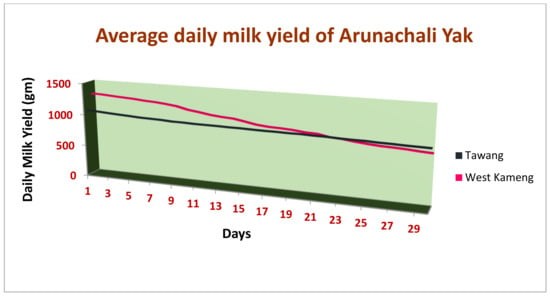
Figure 6.
Average daily milk yield of Arunachali yaks in the Tawang and West Kameng districts recorded over thirty days.

Table 3.
ANOVA for variation in the average daily milk yield in the Arunachali yak home tract.
The average dry period was found to extend for up to a year and the average lactating yaks/herd was found to be as low as 19%. Both of these parameters are indicative of the subsistence farming pattern that is prevalent in the region [36]. Both the fat (7.45%) and SNF (11.5%) content in the milk of Arunachali yak were very high. The general milk performance characteristics of the Arunachali yak animals are indicated in Table 4.

Table 4.
Dairy performance characteristics of Arunachali yak animals in different lactations.
Three types of fibres, namely, coarse (79–90 microns), mid-type (20–50 microns) and down (16–20 microns) fibres, were obtained from the yaks. The yak wool/fibre has greater strength or breaking load and more resilient down fibre than that of typical sheep wool, as the content of amino acid is higher in yak wool [37]. Down fibre is very warm, hypoallergenic, odour-resistant and water-resistant, with the potential to emerge as a luxury fibre [38]. The softness of yak wool prepared from down fibres is comparable to cashmere (one of the soft wools with a fibre diameter of fewer than 18.5 microns [37]). It suffers less from static electricity disturbances and gives a high degree of heat insulation due to its rich content of myristic acid, thus allowing the wool to keep the wearer warm even when wet. Thus, regarding yak hairs particularly, the softer down fibre has huge market potential to be spun into beautiful shawls, scarves, wraps and other clothing [39].
The average age of clipping coarse hair fibres was 12–18 months, with an average yield of 1.5 kg yield per clipping per animal. Generally, the coarse hair fibres were straight, of medium length and had a 50–100 micron diameter. The average age of clipping down fibre and the average collection per animal per clipping were 12 months and 0.5 kg, respectively. The down fibres were short with a 16–20 micron diameter. The down fibres collected from young calves had more market demand than the other fibres. The descriptions of the fibre quality traits are outlined in Table 5.

Table 5.
Fibre characteristics in Arunachali yak animals.
As far as the growth traits were concerned, the average birth weights were recorded to be 13.8 kg and 13.2 kg in males and females, respectively. The average weights of females at first mating and first calving were recorded to be 228 kg and 234.2 kg, respectively. It was deduced that the adult body weight declined by 20–30% in both males and females during the winter due to the scarcity of feed. The bodyweight measurements for the Arunachali yaks are shown in Table 6.

Table 6.
Growth performance characteristics for the Arunachali yaks.
The fertility of animals is critical to ensure the dual benefits of normal calf crops and the ensuing lactation [40]. The age of sexual maturity of an Arunachali yak bull was 24 months, whereas the age of first mating was recorded to be 34–36 months.
In females, sexual maturity was attained at 34–36 months, while first calving was noticed at 43–45 months. The pastoralists preferred the natural mating of animals, and generally, two to three services were required for each conception. The calving interval was very long, with an average of 510 days and twinning was rarely observed. Placental retention was reported as a major reproductive problem in animals. The reproductive parameters of the Arunachali yaks are described in Table 7.

Table 7.
Different reproductive traits in the male and female Arunachali yaks.
3.4. Tolerance to Extreme Climate Events
As interpreted from the survey, the yak herders in Tawang unanimously rated their animals to be very highly tolerant to drought (100%) and cold (100%) and average in tolerance to heat stress (100%). On the other hand, the response in the West Kameng district was more diverse for the three types of stressors in the yaks. Though the majority of herders rated their animals to be very highly tolerant to drought (85.7%), a few rated their animals in the high (4.03%), average (5.12%) and poorly tolerant (5.12%) categories as well. Similarly, the animals were rated to be high (1.08%), average (1.08%), poor (37.8%) and very poor (59.9%) in terms of heat tolerance in West Kameng. A total of 83.8% of herders rated their animals to be very highly cold tolerant, while some were even rated to be very poorly tolerant to extreme cold (4.03%). The hardiness potential of yaks in the two districts is illustrated in Figure 7.
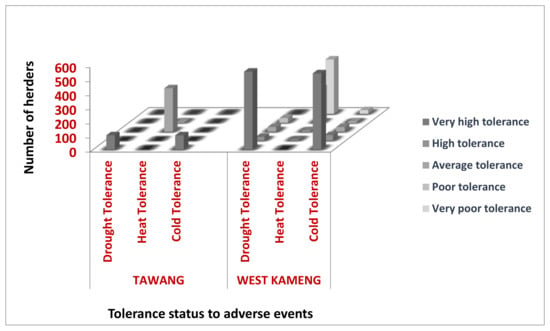
Figure 7.
Tolerance of yaks to adverse climatic events in the two districts on a scale of 1–5 as informed by the yak herders. 1—very high tolerance, 2—high tolerance, 3—average tolerance, 4—poor tolerance and 5—very poor tolerance.
The wide discrepancy between the data from the two districts was somewhat confusing. However, the larger picture was in sync with already known physiological facts that yaks can withstand extreme drought and cold conditions to a larger extent, with poor tolerance to heat stress.
3.5. Prevailing Production Systems
The Arunachali yaks were reared by tribal Monpa pastoralists in a typical transhumant fashion involving seasonal migration. The survey revealed important information regarding the socio-economic status, migration pattern, husbandry practices and ITKs of yak pastoralists.
3.5.1. Socio-Economic Status of Pastoralists
Arunachali yaks are assets for the economy of the Monpa pastoralist community, who rear them in semi-migratory systems. Yaks are closely involved with the culture, religion and social life of the people, besides providing economic benefits in the form of fibre, dung, meat, milk and milk products, etc. During the summer season, the yak rearers migrate their herds along the mountain ridges away from their homestead for grazing. In winter, when there is heavy snowfall, the entire herd is brought back to areas near villages. Nearly 80% of the tribal population largely depends upon agriculture with shifting cultivation (Jhum). Agricultural crops, including chilli, soybean, potato, cabbage, pumpkin and ginger, as well as horticultural crops, such as kiwi, apple, orange and some other citrus fruits, are the major crops cultivated. Their houses are constructed from locally available materials, with the size and area depending on the family patterns. The average number of family members per household is six, with 50% of them being literate, while 50% are involved in yak husbandry. The average agriculture landholding and annual income of yak farmers are 4500 acres and $1000 per annum, respectively.
3.5.2. Migration Pattern
An average distance of 57.5 km is covered during seasonal migration and about 6–7 months of the year is spent in migration. In Tawang, the majority of pastoralists start their migration from Rho, followed by Jangda, and the major halting points are Taktsang, Yangtse and Zemithang. In the West Kameng district, most of the yak herders start the ascent from Mandalaphudung and Shingchung and the end points of migration are Luguthang and Brokserthang (Figure 8).

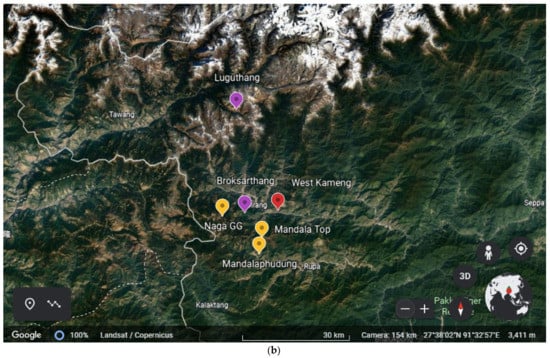
Figure 8.
Start and end points of migration by yak pastoralists in the Tawang (a) and West Kameng (b) districts (yellow—start points and purple—end points).
3.5.3. Husbandry Practices
Shelter: Owing to the extremely harsh climatic conditions of the area, the yak rearers construct their houses with stone and wood with plank floors. Their houses often have beautifully carved doors and window frames exhibiting their skill. To keep the houses warm during the winter, the roof is made of bamboo matting, along with sitting platforms and hearths in the living rooms. During migration, full-walled tribal houses are built to resist severe cold and hostile environments. However, they lack proper ventilation and drainage systems and the overall hygienic conditions are also very poor during migration. The shelter details of the yak pastoral nomads are given in Table 8.

Table 8.
Housing management practices of yak herders in Arunachal Pradesh.
Feed: Maize grain, rice polish, paddy straw, flour, salt and tree leaves comprised the main feed components for yaks. Green forages were available to them during the summer months and were fed chaffed or unchaffed. However, feed resources became scarce during the winter and dry fodder was the only available feed option during the cold, winter months. Furthermore, non-conventional feed resources, viz., crop residues such as straw, stover, and some tree foliage, are fed to the animals during the winter fodder scarcity period. The feed and fodder management practices of yak rearers are presented in Table 9 and Table 10.

Table 9.
Feed management practices of the yak rearers.

Table 10.
Fodder management practices of the yak rearers.
Diseases: Diseases in yaks are most widespread when they descend to mid and low altitudes in September and May, as there is a wide prevalence of ticks and lice. Helminth infections are very common in calves in these areas causing heavy calf mortality. The most prevalent diseases in the two districts based on the survey were foot and mouth disease (FMD), diarrhoea, babesiosis and other viral diseases with prevalence rates of 56%, 22%, 13% and 9%, respectively, in Tawang and 61%, 20%, 12% and 8%, respectively, in West Kameng. Although the occurrence of FMD is seasonal, it is the most serious problem and its highest incidences were recorded in February and March in both districts. Sometimes, mortality in yaks was also observed due to overgrazing and the intake of toxic weeds. The present survey report indicated that herbal, allopathic and local treatments were being used by the yak rearers. Herbal remedies were being most frequently used and allopathic and local treatments were often followed less. In West Kameng, 40% of herders followed allopathic treatment as compared with 20% in Tawang.
3.5.4. ITK of Yak Pastoralists
The Indigenous traditional knowledge of yak breeding and management by pastoralists is being practised in both the West Kameng and Tawang districts of Arunachal Pradesh for the multiplication of animals and to maintain genetic diversity. Moreover, ethnoveterinary practices were employed for disease diagnosis, treatment and prevention. The survey revealed that the yak rearers selected both males and females in their traditional breeding program by following certain definite criteria based on the phenotypic characters and productivity of the animals. Informal rural social institutions played a decisive role while exchanging yak bulls for breeding purposes. To treat many diseases and disorders in the yaks, a traditional alcoholic beverage called rakshi, which is made of indigenous grains and millet, was also used. Some of the yak cures were based on perceptive observations, e.g., different body parts of fishes were given to the yaks, along with local beer made from finger millet and indigenous varieties of maize. These traditional cures were generally fed to weak and old yaks. A mixture of corns and stems of Colocasia and tender leaves of Urtica spp. were boiled till their quantity was reduced by 50% and were given to pregnant yaks to improve their health. These herbal remedies and local treatments need proper documentation and research to acknowledge the intangible intellectual wealth of yak pastoralists.
3.5.5. Economic Utility
Yaks provide numerous economic benefits through the production of quality milk and processed milk products, such as Ghee and Chhurpi (fermented paneer). Although yaks are reared in free grazing and semi-migratory system, utmost hygienic care with regard to the cleaning of milking utensils was regularly practised by the pastoralists. However, cleaning of udders before milking was rarely practiced, which may be a cause for concern. Furthermore, soft and coarse fibres, meat and manure also fetched returns for the pastoralists.
Another productive trait of Arunachali yak was pack performance. The male yaks had a working life of 10–12 years and the yak bulls not used for breeding purposes were castrated at an early age and used for load carrying. Generally, F1 male crosses of yaks and hill cattle, i.e., Dzo, which are infertile, are used as pack animals for carrying loads during migration. Dzo can carry between 40 to 70 kg of loads depending on its body condition, which is subsequently influenced by feed and weather conditions.
4. Threats to Arunachali Yak Conservation and Potential Solutions
Based on the present survey, several threats were identified that resulted in a gradual reduction in the yak population and enforced mass desertions. Most of the yak rearing tracts in the region faced an acute shortage of feed and fodder, especially during winter. Winter feed scarcity results in poor production and even death and is usually listed as a prime threat to yak conservation. Another major challenge is poor production performance due to inbreeding and lack of selection of superior bulls, which is hindering long-term conservation efforts [36]. The unavailability of veterinary services in far-flung areas, in particular during migration, is another factor with huge implications for animal health [41]. Finally, extreme weather events such as heavy and unprecedented snowfall can wipe out large populations, bringing the tribal economy to a grinding halt [42].
It was suggested that good pasture management should aim to maintain at least a 20–30% legume component for the fulfilment of the nutrient composition of yaks. Some of the suitable temperate grasses and legumes for the establishment and regeneration of temperate/alpine pastures are cocksfoot (Dactylis glomerata), perennial ryegrass (Lolium perenne), tall fescue (Festuca arundinacea), Timothy (Phelum pretense), white clover (Trifolium repens) and red clover (Trifolium pretense), which are readily available in this region. Other grasses, such as hybrid Napier (Pennisetum purpureum), thin Napier (Pennisetum polystachyon), broom grass (Thysanolaena maxima) and Aruna grass (Setaria palmifolia), are also found in lower and mid altitudes. Some of these temperate grasses and legumes were also found to be useful for the horti-pastoral development of orchards in this region [43]. To combat the acute winter feed scarcity, complete feed blocks and silage preparation can be encouraged to maintain the bodily requirements of yaks [44].
A planned mating programme for the selection and dissemination of superior bulls is required to increase the productivity and genetic variability in the pastoral herds while promoting the adaptability of the breed [18]. Therefore, continuing support and intervention from ICAR-National Research Centre on Yak in Arunachal Pradesh is crucial. Breeding for desirable morphological characteristics (such as a white hair coat), productive traits (such higher fat and protein content in milk and fibre traits such as smaller hair diameter), along with superior adaptive traits (such as drought, heat and cold tolerance), will generate greater economic returns on the one hand and will help in building a climate-resilient pastoral yak population on the other [32,45]). The selection and dissemination of genetically distinct and superior yak germplasm will also promote entrepreneurship opportunities for the youth with regard to the value addition and sale of yak products. This can help in attracting the younger generation to the occupation, and thus, generating employment and garnering profits for the herders.
Although yaks are reared in a very hostile and remote area, treatment and vaccinations could be made accessible to yak rearers. State animal husbandry departments can plan vaccination camps for yaks during their migration and essential medicines can be provided to cover medical exigencies during their stay at remote grazing grounds during summers. The availability of insurance services and interest-free loans for yak farming can further boost yak husbandry by providing risk coverage against weather calamities. More specifically, weather-index-based yak insurance products can be introduced to hedge the risks arising out of slight climatic variabilities, including an increase in the average snowfall in a particular year and a reduction in vegetation availability [46].
The Indigenous traditional knowledge of tribal herders should be used in participatory biodiversity conservation [47,48]. Research and technology development in yak husbandry should be centred on the pastoral sustainability of the yaks so that all the stakeholders benefit.
5. Conclusions
For centuries, livestock breeders have selected and bred their animals, resulting in the consolidation or fixing of particular characters in specific populations. Proper documentation of the phenotypic characteristics of a population is the most important step to characterize it as a breed. Yak pastoralists have been pursuing a transhumant lifestyle in the Himalayan highlands. Hence, yak conservation is pivotal for sustaining highland pastoralism, ecological diversity and rich cultural heritage. Nomadic yak herding in Arunachal Pradesh employs high mobility combined with ecosystem awareness and inherited traditional knowledge. Though it is a subsistence economy, the social, cultural and civilizational impact of yak herding on the tribal population is priceless. The characterization of yaks of Arunachal Pradesh as a breed, viz., Arunachali yak, marks a new dawn in the area of pastoral recognition and sustainability in India. This study describes the phenotypic characterization of the Arunachali yak breed and presents a roadmap for the conservation and improvement of this unique mountain species in the pastoral landscape of the country. Focused and concerted efforts in this direction will rejuvenate yak farming and boost pastoral livelihoods.
Author Contributions
P.J.D. conceptualized the study; P.J.D., S.D., S.S.B., S.M. and J.S. conducted the survey and collected the data; P.J.D., S.M. and A.K. carried out the analysis; P.J.D., A.K., V.P., M.P. and M.S. wrote and critically reviewed the manuscript. All the authors approved of the final submitted version and agree to be personally accountable for their own contributions, as well as for the accuracy or integrity of any part of the work. All authors have read and agreed to the published version of the manuscript.
Funding
Authors are grateful to the ICAR-Indian Council of Agricultural Research, New Delhi for financial assistance to carry out this project.
Institutional Review Board Statement
The animal study protocol was approved by the Institutional Animal Ethics Committee of ICAR-National Research Centre on Yak (Approved protocol number 4(17)/NRCY/IAEC-02 dated 01-08-2013).
Informed Consent Statement
Informed consent was obtained from all the subjects involved in the study.
Data Availability Statement
The data presented in this study are available on request from the corresponding author. The data are not publicly available due to further pending analysis.
Acknowledgments
All the authors express their sincere thanks to ICAR for supporting and strengthening this research. Authors are also very much thankful to ICAR—National Bureau of Animal Genetic Resources, Karnal, India, the Nodal Agency to carry out this project. Authors duly acknowledge Directors, ICAR-NRCY and ICAR-NBAGR for granting permission to avail the facilities to carry out this project.
Conflicts of Interest
All the authors declare that they have no conflict of interest.
References
- Coppock, D.L.; Ellis, J.E.; Swift, D.M. Livestock Feeding Ecology and Resource Utilization in a Nomadic Pastoral Ecosystem. J. Appl. Ecol. 1986, 23, 573. [Google Scholar] [CrossRef]
- Körner, C.; Ohsawa, M. Mountain systems. In Ecosystems and Human Well-Being: Current State and Trends; Hassan, R., Scholes, N.A., Eds.; Island Press: London, UK, 2005; pp. 683–716. [Google Scholar]
- Sharma, V.P.; Köhler-Rollefson, I.; Morton, J. Pastoralism in India: A Scoping Study. 2003. Available online: https://assets.publishing.service.gov.uk/media/57a08ce2e5274a31e00014fa/ZC0181b.pdf (accessed on 5 August 2022).
- Sørbø, G.M. Pastoral ecosystems and the issue of scale. AMBIO 2003, 32, 113–117. [Google Scholar] [CrossRef] [PubMed]
- Bhasin, V. Pastoralists of Himalayas. J. Biodivers. 2013, 4, 83–113. [Google Scholar] [CrossRef]
- Sharifian, A.; Fernández-Llamazares, Á.; Wario, H.T.; Molnár, Z.; Cabeza, M. Dynamics of pastoral traditional ecological knowledge: A global state-of-the-art review. Ecol. Soc. 2022, 27, 14. [Google Scholar] [CrossRef]
- Dong, S.; Wen, L.; Liu, S.; Zhang, X.; Lassoie, J.P.; Yi, S.; Li, X.; Li, J.; Li, Y. Vulnerability of worldwide pastoralism to global changes and interdisciplinary strategies for sustainable pastoralism. Ecol. Soc. 2011, 16, 1–23. [Google Scholar] [CrossRef]
- Liechti, K.; Biber, J.P. Pastoralism in Europe: Characteristics and challenges of highland-lowland transhumance. Rev. Sci. Tech. 2016, 35, 561–575. [Google Scholar] [CrossRef]
- Namgay, K.; Millar, J.; Black, R. The Future of Transhumants’ Sustainable Resource Use in Bhutan: Pressures and Policies. Front. Sustain. Food Syst. 2021, 5, 618351. [Google Scholar] [CrossRef]
- Sharma, A.; Parkash, O.; Uniyal, S.K. Moving away from transhumance: The case of Gaddis. Trees For. People 2022, 7, 100193. [Google Scholar] [CrossRef]
- Wangchuk, K.; Wangdi, J. Mountain pastoralism in transition: Consequences of legalizing Cordyceps collection on yak farming practices in Bhutan. Pastoralism 2011, 5, 4. [Google Scholar] [CrossRef]
- Krishnan, G.; Paul, V.; Hannah, S.S.; Bam, J.; Das, P.J. Effect of climate change on yak production at high altitude. Indian J. Anim. Sci. 2016, 86, 621–626. [Google Scholar]
- Dorji, N.; Derks, M.; Groot Koerkamp, P.W.G.; Bokkers, E.A.M. Transition towards sustainable yak farming in Bhutan: Stakeholders’ viewpoints and recommendations for future steps. Int. J. Sustain. Agric. 2021, 20, 68–87. [Google Scholar] [CrossRef]
- Dorji, N.; Derks, M.; Dorji, P.; Koerkamp, P.W.G.G.; Bokkers, E. Herders’ and livestock professionals’ experiences on past and future developments in yak farming in Bhutan. In Proceedings of the WIAS Annual Conference 2020: Frontiers in Animal Sciences, De Werelt Conference Centre, Lunteren, Netherlands, 13–14 February 2020; Available online: https://www.wur.nl/upload_mm/2/a/6/5123d603-ccbd-4649-bc5e-4d097e79c497_WIAS%20annual%20conference%20proceedings%202020.pdf (accessed on 8 August 2022).
- Rodgers, C. Community engagement in pastoralist areas: Lessons from the public dialogue process for a new refugee settlement in Turkana, Kenya. Pastoralism 2021, 11, 26. [Google Scholar] [CrossRef]
- Biscarini, F.; Nicolazzi, E.; Alessandra, S.; Boettcher, P.; Gandini, G. Challenges and opportunities in genetic improvement of local livestock breeds. Front. Genet. 2015, 6, 33. [Google Scholar] [CrossRef]
- Woodruff, D.S. Populations, Species, and Conservation Genetics. Encycl. Biodivers. 2001, 811–829. [Google Scholar] [CrossRef]
- Kour, A.; Niranjan, S.K.; Malayaperumal, M.; Surati, U.; Pukhrambam, M.; Sivalingam, J.; Kumar, A.; Sarkar, M. Genomic Diversity Profiling and Breed-Specific Evolutionary Signatures of Selection in Arunachali Yak. Genes 2022, 13, 254. [Google Scholar] [CrossRef]
- 20th Livestock Census, 2019: All India Report [WWW Document], n.d. Available online: https://ruralindiaonline.org/en/library/resource/20th-livestock-census-2019-all-india-report/ (accessed on 16 February 2022).
- Touchberry, R.W.; Lush, J.L. The Accuracy of Linear Body Measurements of Dairy Cattle. J. Dairy Sci. 1950, 33, 72–80. [Google Scholar] [CrossRef]
- IBM Corp. IBM SPSS Statistics for Windows, Version 28; IBM Corp: Armonk, NY, USA, 2013.
- Chen, S.Y.; Huang, Y.; Zhu, Q.; Fontanesi, L.; Yao, Y.G.; Liu, Y.P. Sequence characterization of the MC1R gene in yak (Poephagus grunniens) breeds with different coat colors. J. Biotechnol. Biomed. 2009, 2009, 861046. [Google Scholar] [CrossRef]
- Zhang, M.Q.; Xu, X.; Luo, S.J. The genetics of brown coat color and white spotting in domestic yaks (Bos grunniens). Anim. Genet. 2014, 45, 652–659. [Google Scholar] [CrossRef]
- Ali, S. Yak. The cryophilic species of Baltistan; Ferozsons (Pvt.) Ltd.: Lahore, Pakistan, 2015. [Google Scholar]
- Simon, R.; Drögemüller, C.; Lühken, G. The Complex and Diverse Genetic Architecture of the Absence of Horns (Polledness) in Domestic Ruminants, including Goats and Sheep. Genes 2022, 13, 832. [Google Scholar] [CrossRef]
- Klingenberg, C.P. Morphometrics and the role of the phenotype in studies of the evolution of developmental mechanisms. Gene 2002, 287, 3–10. [Google Scholar] [CrossRef]
- Vanvanhossou, S.F.U.; Scheper, C.; Dossa, L.H.; Yin, T.; Brügemann, K.; König, S. A multi-breed GWAS for morphometric traits in four Beninese indigenous cattle breeds reveals loci associated with conformation, carcass and adaptive traits. BMC Genomics 2020, 21, 783. [Google Scholar] [CrossRef]
- De Melo, B.A.; de Gusmão Couto, A.; de Lima Silva, F.; Hongyu, K.; Teodózio de Araújo, F.C.; Mesquita da Silva, S.G.; Santos Rios, R.R.; dos Santos, M.T.; Bossi Fraga, A. Multivariate analysis of body morphometric traits in conjunction with performance of reproduction and milk traits in crossbred progeny of Murrah × Jafarabadi buffalo (Bubalus bubalis) in North-Eastern Brazil. PLoS ONE 2020, 15, e0231407. [Google Scholar] [CrossRef]
- Wang, J.; Li, X.; Peng, W.; Zhong, J.; Jiang, M. Genome-Wide Association Study of Body Weight Trait in Yaks. Animals 2022, 12, 1855. [Google Scholar] [CrossRef]
- Peng, X.W.; Ou, Y.X. The ecological adaptability of wild yak (Bos mutus). Ecol. Domest. Anim. 1999, 20, 20–23. [Google Scholar]
- Liang, C.N.; Yao, J.; Yang, B.H. The resources value and protectionstrategy of wild yak. Chin. Wildl. 2005, 25, 6–7. [Google Scholar]
- Singh, T.P.; Deshwal, G.K.; Bam, J.; Paul, V. A Comparative Appraisal of Traditional “Ghee” Derived From the Three Genotypes (Arunachali Yak, Yak–Cow Hybrid, and Cow) Reared Under Semi-Intensive Conditions. Eur. J. Lipid Sci. Technol. 2021, 124, 210010. [Google Scholar] [CrossRef]
- Zhang, R.C. Yak of China; Gansu Science and Technology Publshing House: Lanzhou, China, 1989; pp. 1–98. [Google Scholar]
- Dong, Q.M.; Zhao, X.Q.; Wu, G.L.; Chang, X.F. Optimization yak grazing stocking rate in an alpine grassland of Qinghai-Tibetan Plateau, China. Environ Earth Sci. 2015, 73, 2497–2503. [Google Scholar] [CrossRef]
- Pal, R. YAK (Poephagus grunniens L.) of India. Anim. Genet. Resour. Inf. 1993, 12, 59–67. [Google Scholar] [CrossRef]
- Pandey, N.K.; Somvanshi, S.P.S.; Kumar, S.; Prakash, B.; Singh, C.K. Yak rearing practices by (Brokpa) pastoralist of Tawang Arunachal Pradesh. J. Entomol. Zool. Stud. 2020, 8, 1067–1071. [Google Scholar]
- Das, P.J.; Bam, J.; Paul, V.; Medhi, D.; Roy, A.N.; Deb, S.M. The Yak Wool; ICAR-National Research Centre on Yak Publication: Dirang, India, 2018; pp. 1–108. [Google Scholar]
- Radclyffe-Thomas, N. Profit and purpose: The case for sustainable luxury fashion. In Proceedings of the 20th Annual Conference IFFTI Fashion Futures Conference Proceedings; Donghua University: Shanghai, China, 2018; pp. 263–270. [Google Scholar]
- Braddock-Clarke, S. Lofty Ambition: Fibre from the Roof of the World; Selvedge: London, UK, 2017; pp. 74–79. [Google Scholar]
- Albarran-Portillo, B.; Pollott, G.E. The relationship between fertility and lactation characteristics in Holstein cows on United Kingdom commercial dairy farms. J. Dairy Sci. 2013, 96, 635–646. [Google Scholar] [CrossRef] [PubMed]
- Wu, N.; Yi, S.; Joshi, S.; Bisht, N. (Eds.) Yak on the Move: Transboundary Challenges and Opportunities for Yak Raising in a Changing Hindu Kush Himalayan Region; ICIMOD: Kathmandu, Nepal, 2016. [Google Scholar]
- Available online: https://www.firstpost.com/india/nearly-300-yaks-died-of-starvation-since-dec-2018-due-to-heavy-snowfall-in-north-sikkim-district-says-official-6619381.html (accessed on 24 August 2022).
- Das, P.J.; Deori, S.; Deb, S.M. Arunachali Yak; ICAR-National Research Centre on Yak: Dirang, India, 2016; pp. 1–199. [Google Scholar]
- ICAR. Annual Report 2020; ICAR-National Research Centre on Yak: Dirang, Arunachal Pradesh, India, 2020; pp. 1–50. [Google Scholar]
- Wiener, G.; Ruijun, L.; Jianlin, H. The Yak. The Regional Office for Asia and the Pacific; Food and Agriculture Organization of the United Nations: Bangkok, Thailand, 2011. [Google Scholar]
- Amare, A.; Simane, B.; Nyangaga, J.; Defisa, A.; Hamza, D.; Gurmessa, B. Index-based livestock insurance to manage climate risks in Borena zone of southern Oromia, Ethiopia. Clim. Risk Manag. 2019, 25, 100191. [Google Scholar] [CrossRef]
- Smith, K.; Barrett, C.B.; Box, P.W. Participatory Risk Mapping for Targeting Research and Assistance: With an Example from East African Pastoralists. World Dev. 2000, 28, 1945–1959. [Google Scholar] [CrossRef]
- Greiner, R.; Bliemer, M.; Ballweg, J. Design considerations of a choice experiment to estimate likely participation by north Australian pastoralists in contractual biodiversity conservation. J. Choice Model. 2014, 10, 34–45. [Google Scholar] [CrossRef]
Publisher’s Note: MDPI stays neutral with regard to jurisdictional claims in published maps and institutional affiliations. |
© 2022 by the authors. Licensee MDPI, Basel, Switzerland. This article is an open access article distributed under the terms and conditions of the Creative Commons Attribution (CC BY) license (https://creativecommons.org/licenses/by/4.0/).